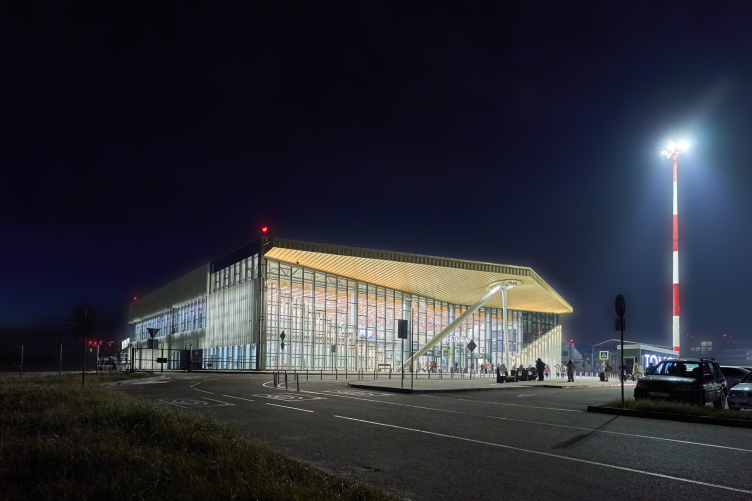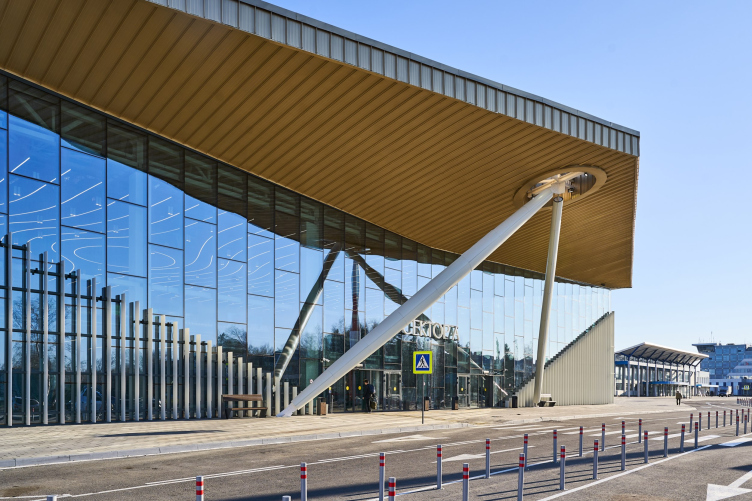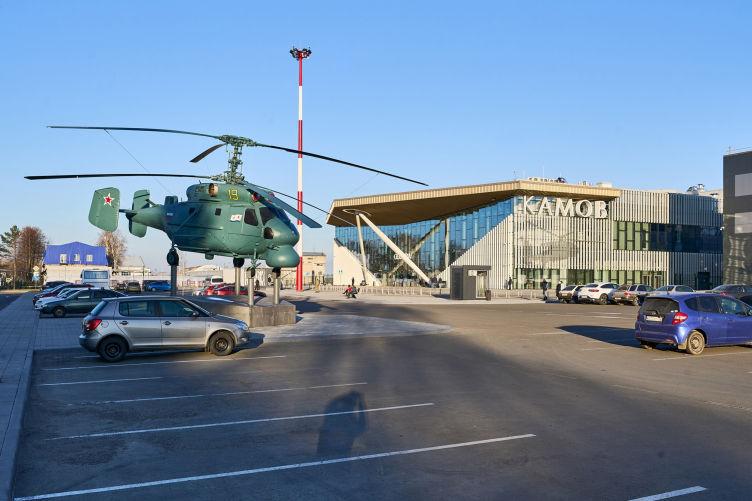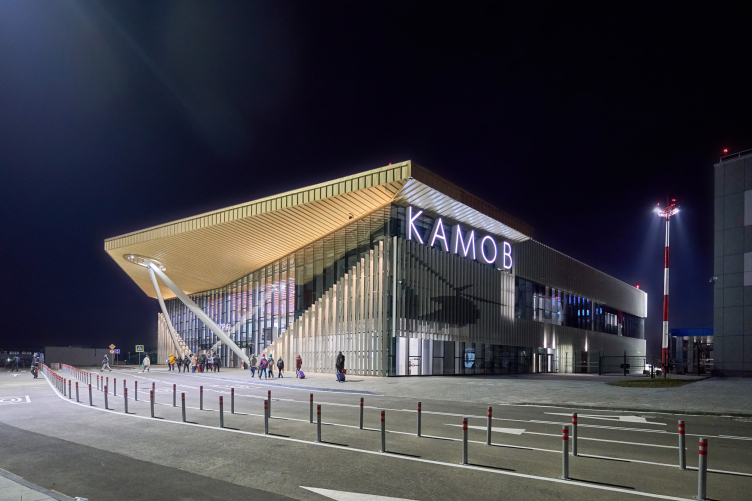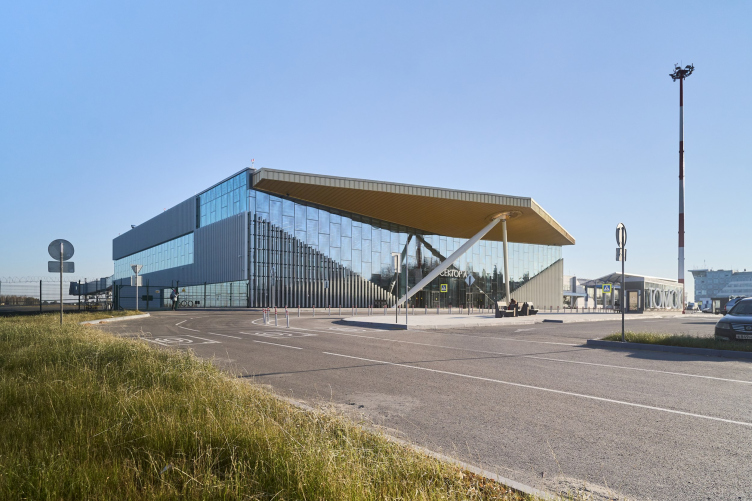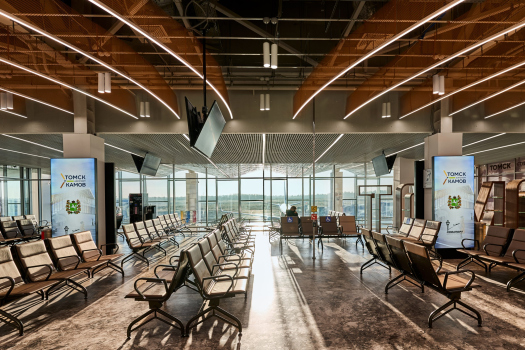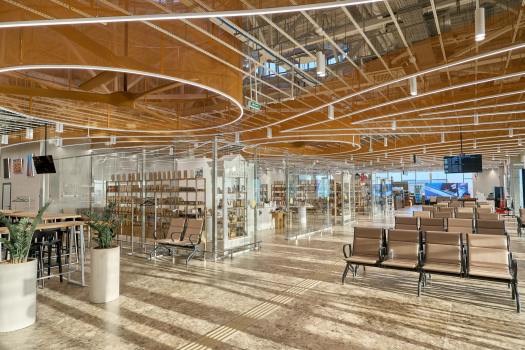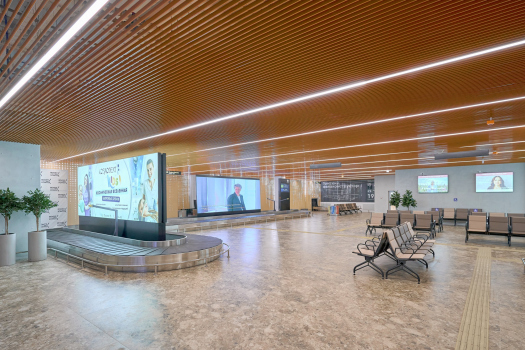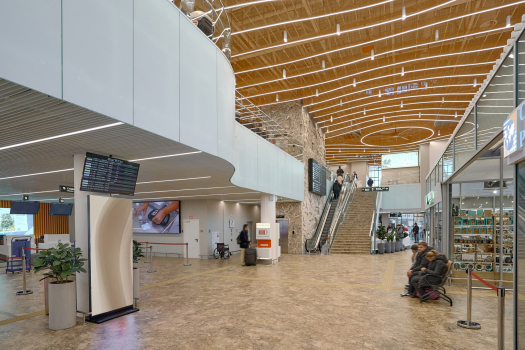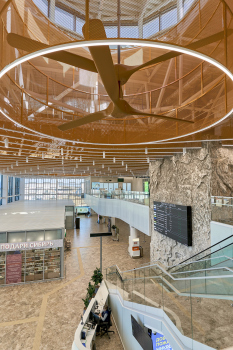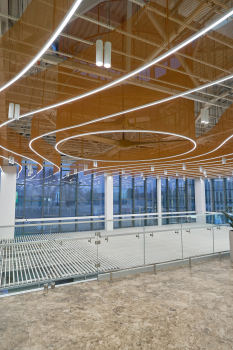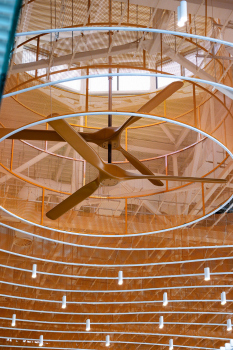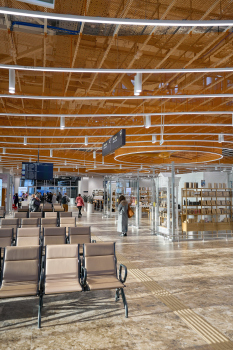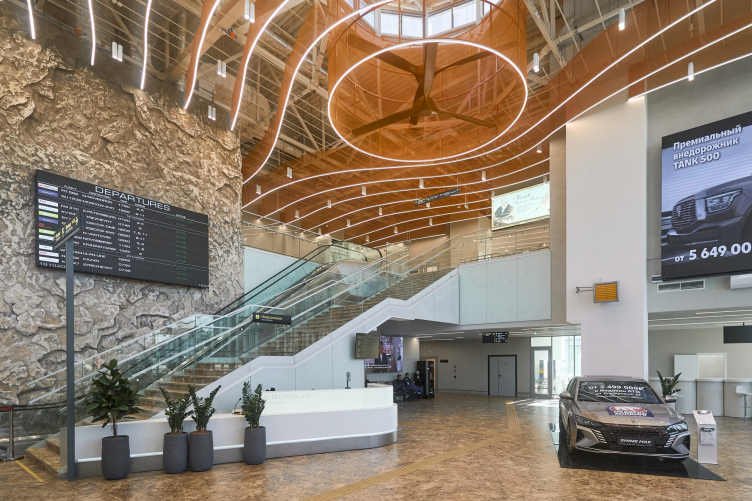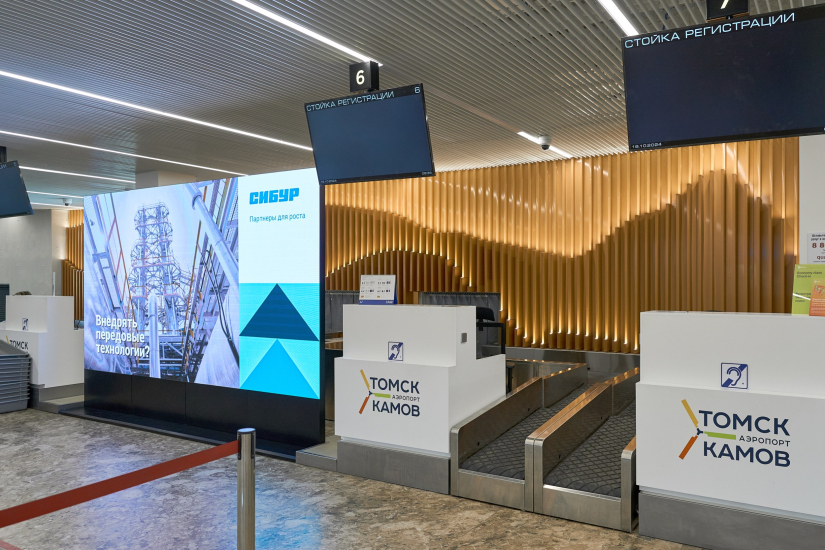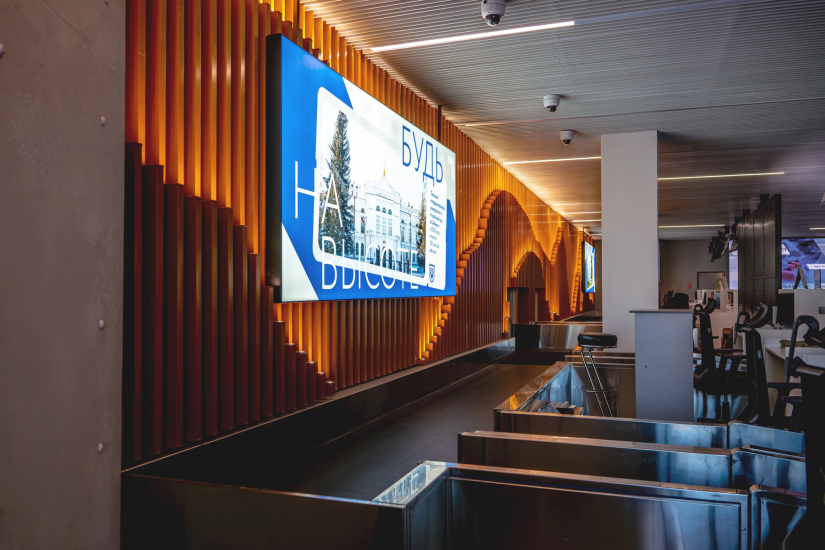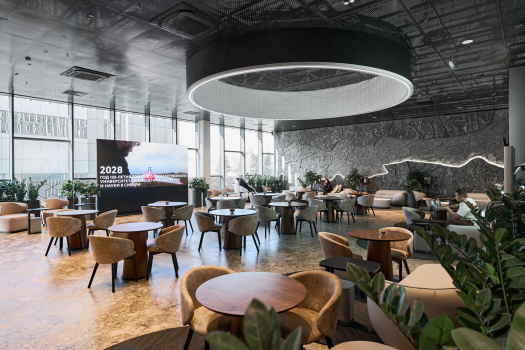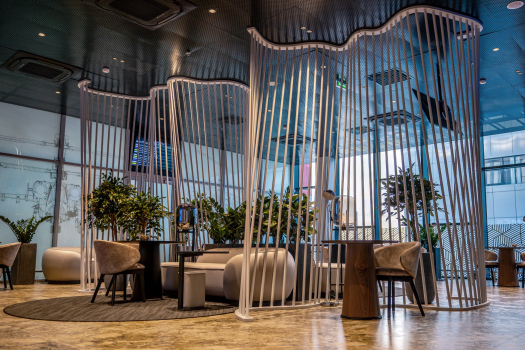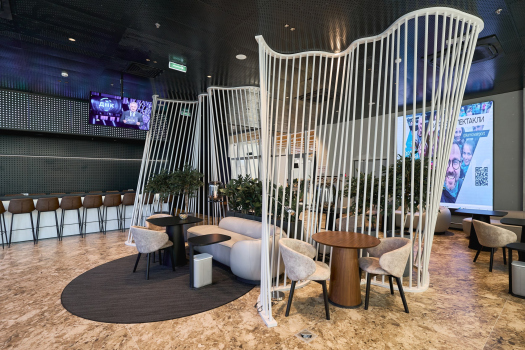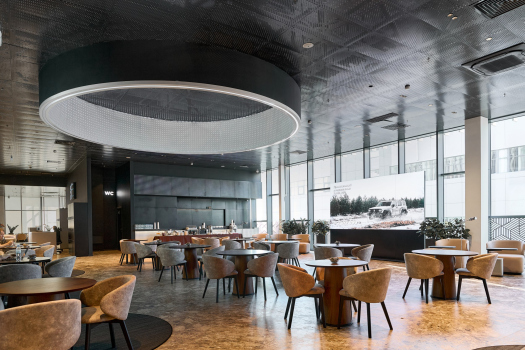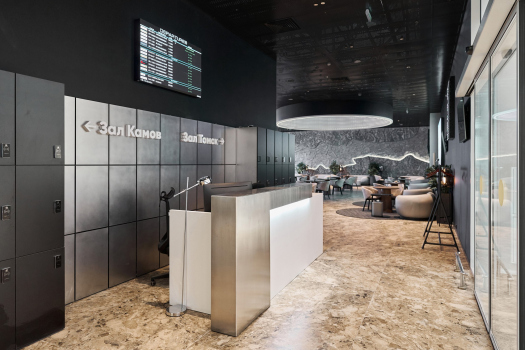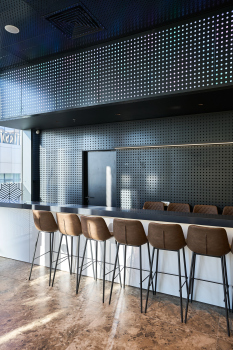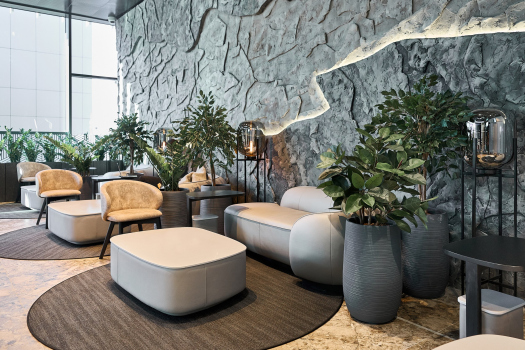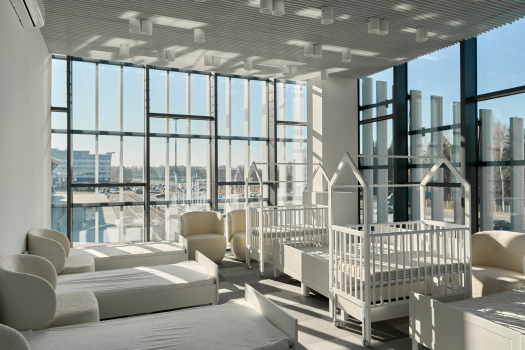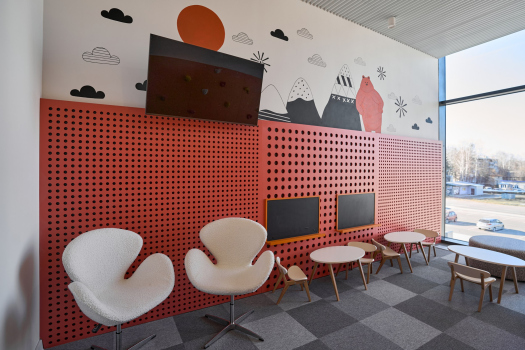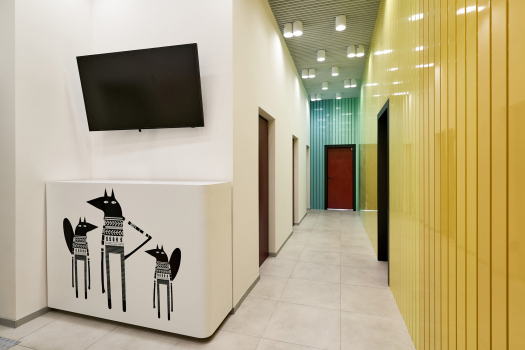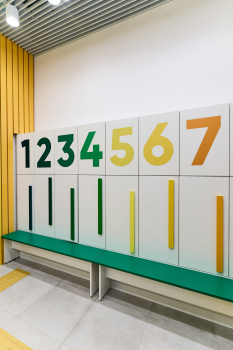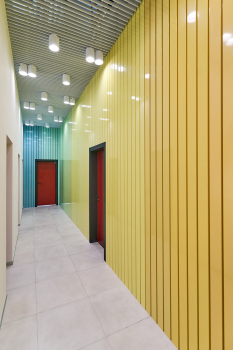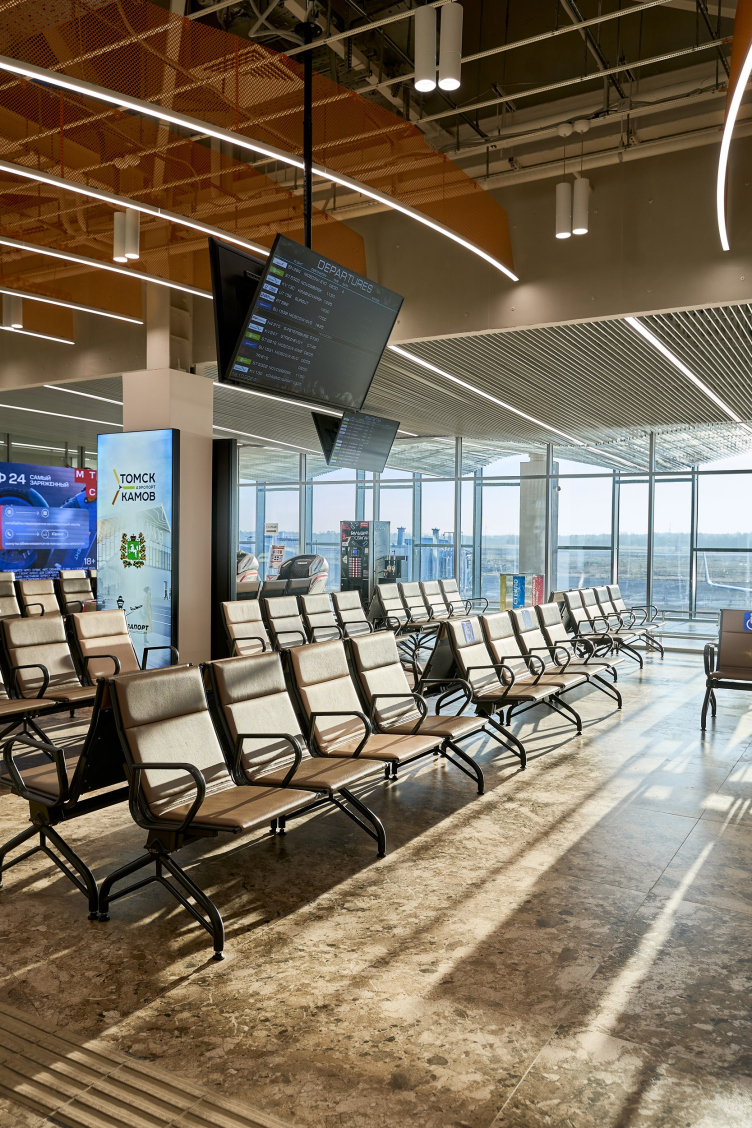The end client of the project was Novaport, the largest private operator of regional airports in Russia, which currently manages as many as 28 air hubs. Between 2013 and 2017, ASADOV Architects designed Bolshoye Savino Airport in Perm for Novaport. Compared to the Perm terminal (26,000 square meters), the Tomsk terminal was nearly four times smaller (7,000 square meters), which also meant stricter budget limits. The task, then, was to remain within a reasonable cost while creating an impressive landmark nonetheless.
Nikolai Kamov International Airport in Tomsk
Copyright: Photograph © Svyatoslav Sobolev / provided by ASADOV Architects
The central idea of the Tomsk project was to draw on the legacy of Soviet aircraft designer Nikolai Ilyich Kamov (1902–1973), creator of the unique coaxial dual-rotor helicopter system used in models carrying the “Ka” designation – from the early Ka-10 and Ka-15 to the legendary Ka-26, Ka-27, and the Ka-50 attack helicopter. Although Kamov was born in Irkutsk, he was closely tied to Tomsk through his work, which is why the airport bears his name. It was also Kamov who introduced the Russian word “vertolyot” as a native replacement for the international “helicopter”.
Nikolai Kamov International Airport in Tomsk
Copyright: Photograph © Svyatoslav Sobolev / provided by ASADOV Architects
The key element of the architectural solution is a spectacular canopy above the terminal’s entrance, supported by two diagonal struts. Beyond its utilitarian purpose of sheltering passengers from the weather, it alludes to the aesthetics of early aviation, recalling the braced structures of biplanes. From the canopy, decorative lamellae spread symmetrically along the façade, creating a dynamic rhythm and enhancing the associations with aviation: the slats resemble blades of grass parted by the upward thrust of a helicopter taking off.
Nikolai Kamov International Airport in Tomsk
Copyright: Photograph © Svyatoslav Sobolev / provided by ASADOV Architects
The architects did not forget about helicopters either: in front of the terminal stands an actual rotorcraft, like a monument to itself, while the silhouette of another machine is laid out in contrasting black-and-white lamellas on a side façade. Above it, there is a three-dimensional “KAMOV” inscription, integrated into the architecture. ASADOV has a fondness for playing with typography – recall the giant Russian letter “П” in Perm that they turned into a portal-entryway at that airport. The typeface here, evoking the 1960s – the golden age of aviation – uses varying stroke thicknesses to create the illusion of letters pivoting toward the forecourt. This technique not only amplifies the sense of motion but also improves legibility for arriving passengers. The other two large inscriptions – “Tomsk” and “Томск” (in Russian) – face the airfield, but those letters are flat, without relief.
Nikolai Kamov International Airport in Tomsk
Copyright: Photograph © Svyatoslav Sobolev / provided by ASADOV Architects
The façades of the terminal are made partly of transparent glass and partly of opaque stemalite – a special kind of glass with a ceramic coating. The client insisted on glass in order to save on cost and accelerate the pace of construction. To avoid the monotony of continuous glazing and to disguise the joints between different panel types, ASADOV Architects used aluminum lamellas – a tried-and-true architectural technique that inevitably adds expressiveness to the building. The effect is especially striking in the evening, when the lighting is on.
The ratio of lamellas-to-glazing varies on each of the four façades. On the airfield side, the lamellas are almost absent, whereas on the side façades the lamellas – and more precisely, the strips of clear glass left between them – visually underscore the flow of passengers boarding and disembarking aircraft. It is these lamellas that give the building its unique recognizable look. This is a good example of how a single, well-considered and relatively simple element can create a powerful image.
Nikolai Kamov International Airport in Tomsk
Copyright: Photograph © Svyatoslav Sobolev / provided by ASADOV Architects
Battle for the airflows
The most striking part of the project hides inside, literally – under the ceiling, whose décor became the key theme of the interior. “Up above”, the architects depicted the movement of air currents: twisting ribbons of golden expanded mesh, frozen in space like sculpted wind. The idea had appealed to the client back at the visualization stage, but during installation a problem arose: point-fixings deprived the mesh of its fluidity – the smooth, airy curves that were essential. More than once, the builders suggested abandoning the concept as unfeasible, but the architects fought to the end.
The solution was to reinforce the lower edge of the ribbons with a metal profile, which preserved their undulating form. Neon light tubes were integrated into the profiles as well, making the ceiling’s sculptural presence even stronger.
In the round skylights, the team installed structures stylized as three-blade coaxial rotors – Kamov’s signature invention. These are purely decorative: large enough to be noticeable but without blocking natural daylight. At first, the idea of installing real fans in the skylights was considered, but in the end the choice was made in favor of aesthetics without functionality, keeping ventilation outside the artistic concept.
Name that tune
The ceiling is not the only flourish of Kamov Airport. The interior is “coded” with so many references to local landmarks and context that it could almost serve as a treasure hunt for schoolchildren.
For example, the registration hall’s elevator block, stylized as a cliff, alludes to “Blue Bluff”, a natural geological monument on the Tom River. The “rocky” texture inside the terminal is actually an imitation: the required relief was shaped with insulation of varying thickness, then plastered and painted.
Nikolai Kamov International Airport in Tomsk
Copyright: Photograph © Svyatoslav Sobolev / provided by ASADOV Architects
In the check-in area, behind the baggage conveyor, the wall is clad with slats forming a wave-like relief. Backlighting accentuates the play of light and shadow, creating the effect of a hilly landscape. The abstract panorama evokes the natural outlines of Shelomok Hillfort – an ancient archeological site near Tomsk – subtly weaving local history into the modern airport space and reminding travelers of the city’s deep connection with its ancient land.
In the business lounge on the second floor, which has a somewhat glamorous look thanks to its dark walls and gray velvet-upholstered furniture, the space is zoned with “screens” made of white metal rods. They read like art objects, evoking associations with natural phenomena – sunbeams breaking through clouds.
The architects even “went the extra mile” with even such minute seemingly insignificant details as painting the walls. Instead of a uniform coat, they created a painterly, uneven texture, leaving gaps between painted segments to mimic the look of metal sheets joined edge to edge, as on airplanes and helicopters.
We always design façade lighting. After all, the airport operates around the clock, and most of the time it is seen illuminated. At night, the glass façades become transparent, the interior comes to life, and it becomes clear just how connected everything is.
The “Mother and Child Room” was designed with particular enthusiasm and humor. The corridor leading to it is finished with “candy-colored” panels in pearly green and yellow. Inside, the lockers are numbered with oversized, brightly colored digits, the playroom is hand-painted, and red perforated panels attached to the walls allow for hanging anything from televisions to drawing boards. Only the children’s sleeping area raises a few questions: at least two of its walls are completely glazed, and the white cribs and beds placed against the backdrop of the sky look more like a purgatory for innocent souls than actually a place to sleep – especially during the daytime hours. The architects insist that this is not an issue, as roll-down blinds are installed on the windows.
Let there be light!
For ASADOV Architects, it was a matter of principle to create a warm, almost homelike atmosphere in the airport. Modern transport hubs – whether railway stations or airports – are too often sterile, inhospitable environments: harsh neon lights, white plastic, and cold metal.
We painted the walls not as a solid surface, but with a painterly, uneven texture, leaving gaps between segments of paint. We wanted to achieve the same effect as sheets of metal joined edge to edge in the construction of airplanes and helicopters. We even used decorative red rivets to enhance the effect.
We encountered a huge number of challenges during the implementation of this project. The key ones were extremely strict budgetary and regulatory constraints, as well as the large number of stakeholders with whom every component of the interior had to be coordinated. These difficulties became a creative challenge for us. Within the budgetary framework of a standard project, we managed to realize original authorial solutions.
We work with all typologies of interiors and were once again convinced that transport facilities – and airports in particular – are the most complex of all.
We encountered a huge number of challenges during the implementation of this project. The key ones were extremely strict budgetary and regulatory constraints, as well as the large number of stakeholders with whom every component of the interior had to be coordinated. These difficulties became a creative challenge for us. Within the budgetary framework of a standard project, we managed to realize original authorial solutions.
We work with all typologies of interiors and were once again convinced that transport facilities – and airports in particular – are the most complex of all.
Nikolai Kamov International Airport in Tomsk
Copyright: Photograph © Svyatoslav Sobolev / provided by ASADOV Architects
The floors are finished with sand-toned porcelain stoneware, while the seating in the waiting hall is in a latte shade. But the key role in the entire composition is played by the lighting.
A warm spectrum was chosen deliberately – soft on the eyes yet fully functional. After all, an airport is not only a departure point, but also the first impression of a city. And the architects made sure to convey that Tomsk is a welcoming place.




